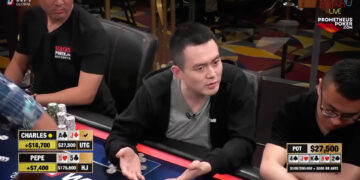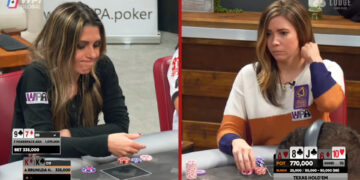How Do You Deal with Poker Tilt? Tilt is the poker word for ‘frustration’. It’s when something goes wrong for a player and that player’s frustration leads to poor poker play. It’s because the player on ‘Tilt’ is now calling too many poker hands because he’s trying to get his money back faster. Tilt is one of your biggest enemies at the poker table, but you can prevent it, or at least slow it down.
In Texas Hold’em Poker Tournaments, your opponents are not your biggest threat. The majority of your opponents will be playing their cards, not the player, and this makes them easier to read when you’re focused. Reading opponents is a conversation for another time. The point here is that your biggest threat in poker tournaments is poker tilt. The reason for that is simple, which is impatience.
Tilt is the Enemy

In the poker world, impatience is the basically same thing as poker tilt. When you go on tilt, it means you’re playing too fast. This equates to playing too many hands (weak hands), calling too often when behind because you’re chasing, and losing your poise. When you continue to put yourself in situations where you’re an underdog, you’re eventually going to lose.
Fortunately, there is a way to avoid tilt. In fact, I wrote an entire book on it, which only happened as a result of a failure at the table because I was on poker tilt. First let me tell you about my failure and what led to the book. Then I will tell you how I resolved the situation. The book I wrote is now my best-selling book of 10 poker-themed books. Why? Because a lot of people are making money by following the poker strategy found in that book.
Several years ago, I was playing a cash game at Harrah’s Cherokee in North Carolina. It was a 2/5 No Limit game and I was running bad. In the beginning of that session, I kept putting myself in situations where I should have won but lost. At that time, I was results-oriented. I am now decision-oriented.
This means that as long as I make the correct decision, I don’t get upset about what happens. It takes a while to get to that point, but it’s a great place to be because you know you will eventually come out ahead if you continue to put yourself in situations where you’re the favorite.
Getting back to that day (when I was still results-oriented), I began to get frustrated. Instead of folding hands like J9-suited from middle position with a lot of calling stations behind me, I was telling myself, “Well, this hand has some potential. I’ll just call and see what happens.”
When that didn’t work, I would pick up a hand like 76-off a few hands later and raise. Sure, that sounds like fun, right? The pros play 76 that way, right? Unless it’s a cutoff or button situation with weak players behind, it’s negative expected value.
As you might have guessed, I lost all my chips. What do you do when you lose all your chips at a cash game? You buy new ones! Yes, I reloaded. This was without going for a walk, eating a meal, walking by the river, or calling a friend. By going straight back into the game, you don’t allow your mind to reset and calm down.
When I returned to the table, I was the same exact player I had been five minutes earlier. Only this time I was more desperate. I was calling with hands like 53 and 95, which is a complete disaster. I was that guy that other players loved to have at their table. Definitely on poker tilt. To make a long story short, I lost all my chips.
With one more bullet in my pocket and a three-hour drive home, I chose to fire one more time. This is what Texas Hold’em Poker can do to you if you don’t have the right mindset. This time, instead of calling, I decided to switch my poker strategy and start raising. This worked for a little while, but I wasn’t just playing with fire; I was running around in the woods during a forest fire. There was no way I would get out alive, and I didn’t. I lost all my chips … again.
A Poker Tilt Epiphany
Instead of leaving the property, I went downstairs, bought myself a light and healthy snack, and took a stroll by the river. All I kept saying to myself was this: There has to be a way to avoid poker tilt. And the only way it can be done is to follow a set of poker rules that nobody has come up with before. If I come up with this set of rules and stick to it, I can test it to see if it’s effective.
At that time, I had no idea where this would lead. I had no intention of writing a book, let alone that book selling and it making tons of poker players a lot of money.
The following is what I came up with to avoid poker tilt. I was only allowed to play Suited connectors, Pairs, Ax-suited, Ten-or-higher hands (both cards ten or higher), and Suited one-gappers. However, I had freedom to play whatever I wanted on the button and blinds (unless raised and holding cards outside of SPATS range).
By only being allowed to play these hands, I was going to have an advantage the majority of the time. At least I knew I wouldn’t be putting myself in situations where I was a huge underdog. I’m not a big fan of suited connectors and suited one-gappers, but I needed to include those types of hands so my opponents wouldn’t peg my poker range with ease.
For example, an opponent that saw me playing only premium cards would never put me on 8d 6d, but that falls within the parameters for this poker strategy.
Raking in the Dough
When I looked back on this strategy, I realized that the first letter for each type of hand you can play spelled out SPATS. Last week, I had a fan (who is now also a friend) send me a picture of a t-shirt he wears that reads: SPATS (with each suit underneath the word). He sent me that picture because he made himself a promise at the beginning of last year.
That promise was that he would only use SPATS in every single poker hand he played throughout the year for small poker tournaments and 2/5 NL cash games. At the end of the year, he netted (not grossed) $80,000. That’s on top of his regular job. I have had scores of other poker players contact me to tell me SPATS has turned them from a losing player to a winning player.
Wrote about SPATS in The Perfect Range, which is a poker adventure/poker strategy book. I only chose to write that book for one reason. Do you remember how I told you I went to get a healthy snack and strolled by the river? Well, I usually leave my ATM card at home so I can only lose the cash I bring, but it just so happened that I had my ATM card with me on this day AND I had just come up with a new poker strategy.
I was down $900 for the day, and the ATM limit at Harrah’s Cherokee is $800. I needed to know. Took out the $800 and went back to the poker room. I also ended up at the same exact table. I’m sure everyone else at that table was happy to see me return, but as the old saying goes, you should be happy what you wish for.
Slowing Down to Increase Cash Flow

I told myself I would invest another eight hours. Knowing I needed to have time to slow down my game and really test out SPATS. I had no idea at the time that the real value of SPATS is that it helps you avoid poker tilt. If you’re forced to only play certain hands, you’re going to avoid tilt.
For example, if you play a poker hand where you have the nut flush on the turn and your opponent calls your shove with two pair and hits the full house on the river, you’re not going to be happy. If you’re like most poker players, you’re going to want your chips back fast. You’re dealt a hand like A8-off at some point over the next few hands, you’re going to be tempted to call, not realizing that A8-off is a huge trouble hand.
You’re following SPATS and you lose with that nut flush and are then dealt A8-off at some point over the next few hands, you have to fold. If you fold there, you’re not just avoiding poker tilt, you’re demonstrating simple discipline. Other players are going to pick up on this after a while, and when they pick up on this, they are going to have massive respect for your game, simply because you never get rattled.
Decision-Oriented
As a side note in relation to never getting rattled. When you lose a hand because of a suckout, don’t react whatsoever. Show zero emotion. This will scare the heck out of your opponents. It shows that you are a true pro and have been in that situation thousands of times before. It also shows that the money isn’t important to you (even if it is) and that you’re decision-oriented, not results-oriented. This also shows that you avoid poker tilt.
Additionally, never show emotion when you win a big hand. This looks amateurish. When I see someone celebrate winning a big hand, I immediately think to myself: an inexperienced player. Attack at the right time. You don’t want professional poker players thinking this about you. I would highly recommend doing your best to never show emotion. Be stoic at the poker table.
A Completely Different Player
Getting back to that first poker session applying SPATS. I slowed down my game so much that after about 1.5 hours, another player said, “You seem like a completely different player since you came back. What did you do while you were gone for a half hour?” My reply, “I went for a walk.”
Stop Talking!
This relates to another important poker tip for Texas Hold’em Poker. When you’re playing poker, everything you do and say conveys information. If I can get someone to talk, they’re making a big mistake. At the same time, you don’t want to be a jerk by not replying to someone.
When someone talks to you, keep your answers short and sweet, then get back to the game. When you’re chatting, you also remove the mysterious aura you had earlier, and you’re not going to be as intimidating. Forget the feelings of the other players.
To this point, when I once told a friend that I was playing in a local game and doing well but becoming friends with someone of those players and not winning quite as much, my friend said, “You have to make a decision. Are you there to make money or are you there to make friends?” He wasn’t saying one was correct and one was incorrect, but it was an excellent question.
Turning It Around
Ended up winning $1557 in that 2/5 poker session, which made me +$657 for the day. I never would have thought that to be possible prior to going for that walk by the river. I also never would have thought I would come up with a new poker strategy that is now used by many in the poker world. It truly does work. That being the case, I have applied it to Texas Hold’em Poker Tournaments. This has led to results I never would have thought possible, including six wins and 15 final tables in less than one year. This all happened because I came up with a poker strategy to avoid poker tilt.
I’m not saying SPATS is what will work for you. Just saying that it’s imperative to come up with a game plan that will help you avoid tilt. I promise you that the following is true. I play in a lot of WSOP Circuit events, and at least half of those players, which are professional poker players, fail because they eventually blow up. In other words, they lose their patience. If you can be one of the players who don’t blow up, you have a chance.
♠ pokerjournal.org
Poker Tilt – FAQ
What does tilt mean in poker?
Tilt means you're now making emotional decisions because something bad recently happened. Once you go on tilt, you're doomed unless you get lucky. You can avoid tilt by going for a walk after something bad happens.
How do I stop getting tilted in games?
You have several options. Fold more often to reduce variance, go for a walk, get something to eat, make a phone call, play poker golf or read a book.
How do you overcome tilt?
You get to a certain point where tilt is no longer a factor. When you show that nothing fazes you at the poker table, you will gain much respect because your opponents will know you're unflappable.
How can I get my opponents on tilt?
In many ways. I would recommend reading Poker Notes for this, but for now, you can show a bluff, talk to them when they don't want to be talked to, or go for a long-shot draw because they're a strong player and you want to lead them to Frustration Land.


















Discussion about this post